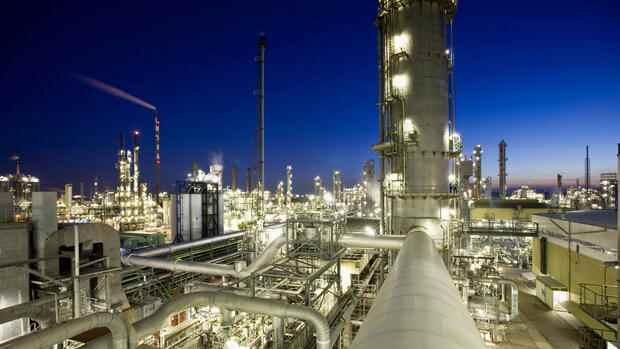The plants are the core of the entire chemical production.
(Photo: BASF SE)
Dusseldorf One of the most important projects for the green conversion of the chemical industry started on Thursday at BASF’s Verbund site in Ludwigshafen. It’s about so-called steam crackers, which are considered the heart of globally networked chemical production, but emit large amounts of CO2. Instead of gas, they are to be operated with electricity from renewable sources in the future.
To this end, BASF and two partners are now starting construction of a test facility that is scheduled to go into operation in 2023 and whose technology is to be marketed worldwide from as early as 2025. On Thursday, the Ludwigshafen-based company laid the foundation stone for this project together with the Saudi Arabian chemical giant Sabic and the Linde Group as plant constructors.
The aim is to make the core petrochemical plants almost climate-neutral. In steam crackers, crude oil products are broken down using a great deal of energy. This results in basic chemicals such as ethylene and propylene, from which plastics and specialty chemicals are obtained.
The steam crackers are therefore at the very beginning of the production chain and are found in every large petrochemical complex in the world. It is estimated that around 300 million tons of CO2 are emitted worldwide every year when cracker furnaces are operated using natural gas.
Top jobs of the day
Find the best jobs now and
be notified by email.
For BASF, the conversion of five of its own steam crackers to operate with green electricity is probably the decisive lever for achieving the climate goals. In 2020, the crackers were responsible for 3.5 million tons of CO2 and thus for more than 20 percent of the greenhouse gas emissions generated in the BASF business. The people of Ludwigshafen want to reduce their CO2 emissions by a quarter by 2030 and work completely climate-neutral by 2050.
Brudermüller: “More urgent than ever”
BASF CEO Martin Brudermüller emphasized on Thursday that projects such as the E-Cracker are becoming even more important in the current difficult geopolitical situation with record high gas prices. “It is more urgent than ever that we become less dependent on oil and gas,” he said.
When building the demo plant for electrically operated steam crackers, BASF and Sabic each contribute their experience in process engineering. Sabic is part of the world’s largest oil company Saudi Aramco. The Arabs maintain large petrochemical complexes in the Gulf region to process crude oil. Linde brings the technological knowledge in plant engineering with it.
Nothing is known about the investment amount. The project is funded by the Federal Ministry of Economics with 15 million euros. Not only the federal government expects the pilot project to be a model. “European chemistry is important for the development of chemistry worldwide, especially in terms of innovation,” said Sabic CEO Yousef Al-Benyan.
After a successful trial phase, the electric steam cracker should be ready for sale to the large petrochemical producers towards the end of 2024. The technology is designed in such a way that it can also be installed in existing systems.
However, converting these core elements of the chemical industry is anything but easy, emphasized Jürgen Nowicki, head of Linde’s engineering division. For decades, steam crackers have been running on steam heated to a temperature of 850 degrees using gas. Only then is the splitting of the crude oil derivative naphtha possible at all.
Huge amounts of electricity from wind power
In order to reach this level with electrical energy, huge amounts of electricity from wind power are required. Depending on its size, a conventional steam cracker would require 500 to 1000 megawatts of electricity per year. This corresponds to the capacity of a larger offshore wind farm – and that alone for the operation of one system.
BASF has already secured large capacities at several wind farms. Together with Vattenfall and Allianz, the Ludwigshafen-based company is building an offshore wind farm on the Dutch coast, which is scheduled to go into full operation in 2023 and supply the Antwerp Verbund site. With RWE, BASF is building its own wind farm in the North Sea. Its power output should supply the Ludwigshafen site from 2030 – above all the two steam crackers, which will then be electrically operated.
More: In this way, the expensive gas is accelerating the green conversion of energy-intensive industry
